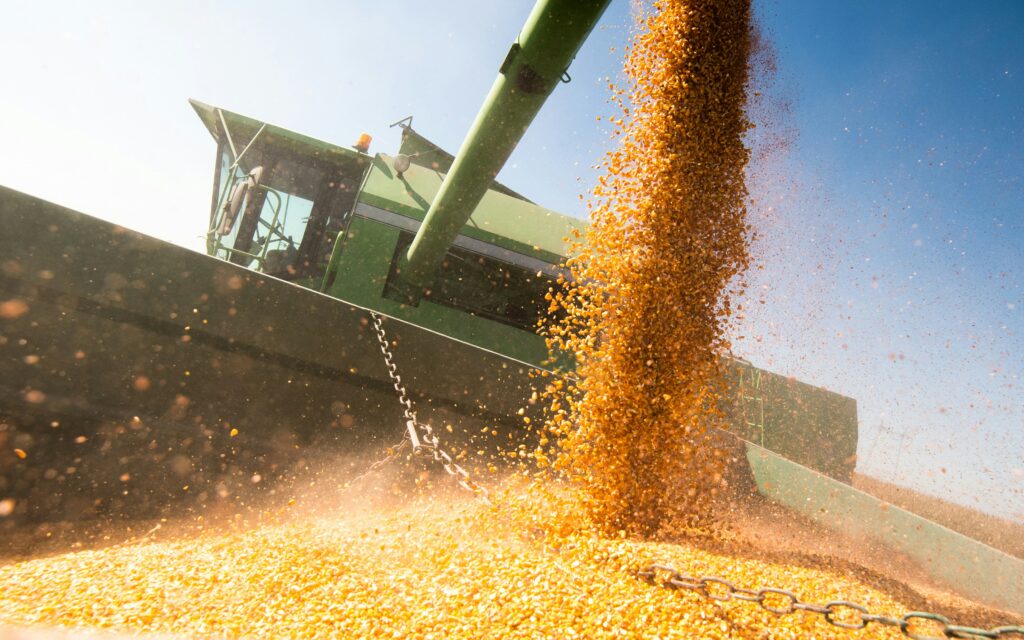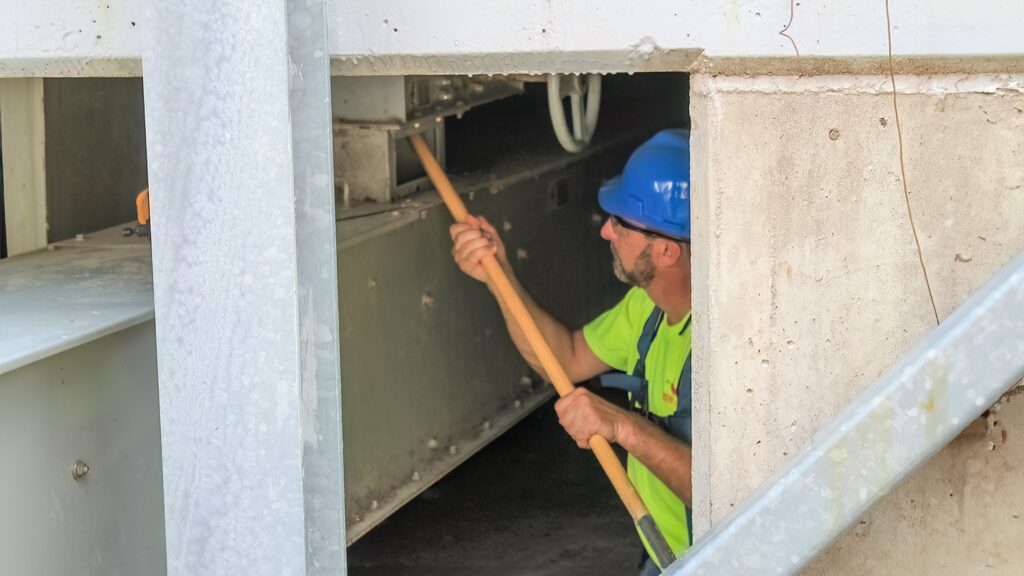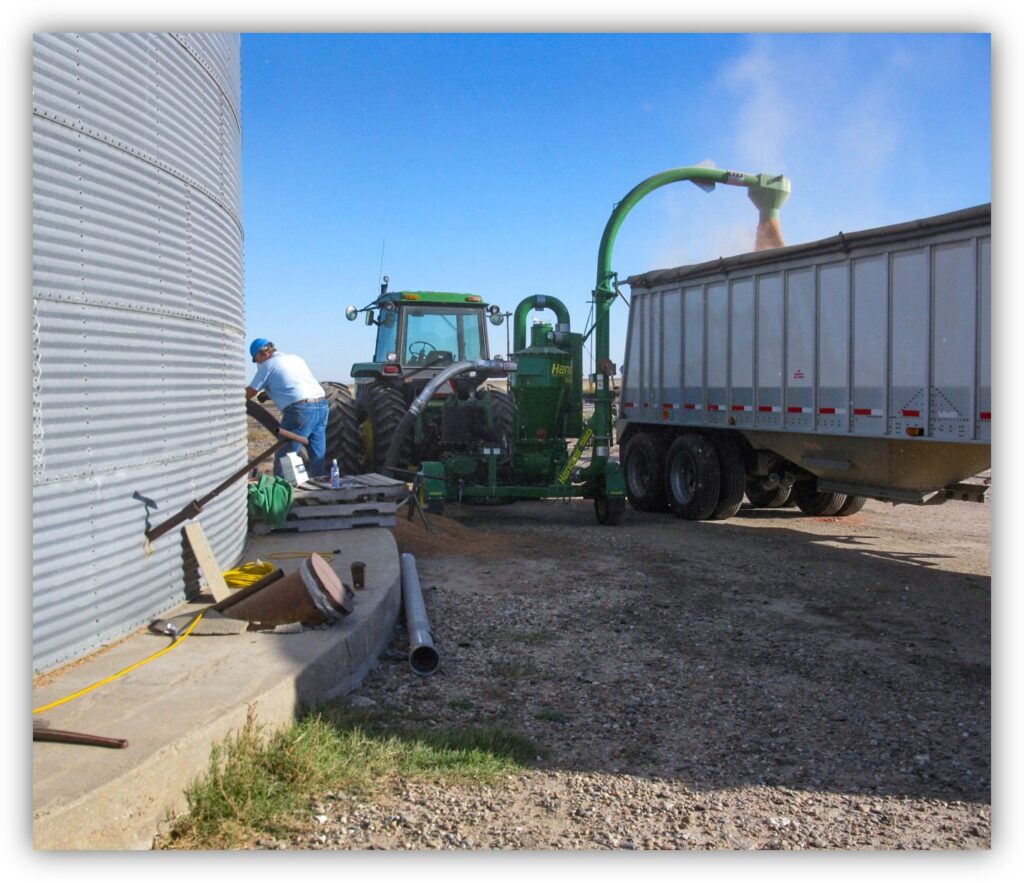Existing strategies for handling out-of-condition grain safely can be split into two broad categories: outfitting the bin; and outside the bin
These strategies were collected through a brainstorming with industry experts in handling grain and grain safety. These have not been tested (except for compressed air) and are not guaranteed to work. This collection is a resource for operators and managers to consider as they develop their own solutions to out-of-condition grain.
Please do let us know what worked/didn’t work for you and we will continue to update and grow this list.
Auger stirators preserve grain quality by stirring, preventing clumping, and maintaining uniform moisture. There are three types:
Vertical stirators are auger devices that are placed upright in the grain bin (perpendicular to the grain bin floor) on a frame suspended from the bin roof that move grain locally from the bottom to the top of the bed. As the frame rotates around the bin, the vertical augers rotate as well, helping to stir and distribute the grain evenly across the grain bin. It can prevent and break up any grain clumps that might form.

Plug busters are designed to be attached and powered by the sweep auger system already in the bin. It is composed of a beater that breaks up grain clumps above the floor sump. In such a system, the sweep auger is left in the bin when it is being filled with grain. A plug buster is designed to handle and operate under the pressure of the grain.
Robotics is a recent development in handling grain with little published research. One of the pioneers of this strategy is the Grain Weevil. These robots use an auger-based propulsion system (think short horizontal segments of augers as wheels) to move across the surface of the grain. As the unit moves across the surface of the grain, it breaks up any crusting and levels the grain after multiple passes. According to the manufacturer, using robotics as a preventative strategy helps maintain grain quality by increasing aeration efficiency, increasing inspection frequency, and breaking up crusted grain. In addition, the Grain Weevil can also be an outside-of-the-bin strategy when used in situations to break up crusted or bridged grain. In the case of bridged grain, breaking and falling through the grain bridge does not harm the robot, as the robot can dig itself out of an engulfment due to its unique auger propulsion system.
Rodding devices break up grain clumps blocking the grain sump. Common solutions include:
Bar on Sump Gates: Rods inserted into sump gates can be moved back and forth from outside the bin to break up clumps. Before any grain is placed in the bin, rods can be directly inserted into the sump gate. When grain clumps up and stops flowing, a worker can then open and close the sump gate while outside the bin to move this rod back and forth. The rod will then break up any grain that is directly above (and blocking) the sump. This approach has been used in both commercial and farm settings and provides the agricultural worker a good option that doesn’t require tunnels with rodding ports under the bins.

The rod over sump solution is very similar to the bar on sump gate solution. This solution requires a worker to drill a small hole at the base of the grain bin and insert a long rod that reaches the center sump. At the end of the rod, a 90-degree elbow is installed to allow the worker to break up grain clumps. The rod is controlled from outside the bin and the bar can be rotated so that it does not protrude when not in use. The benefits of this solution are that it allows workers to lower the rod when not in use and does not impact grain flow. The worker also can move the grain rod up and down and side to side giving them one more degree of freedom than installing rods on the sump gate. However, if the rod is accidently left across the gate opening, the rod itself could cause clumps or plugs to form. This method is potentially more effective in smaller bins than larger storage bins.

Sump alterations modify sump access points and include:
Enlarged sumps are a strategy where the size of the sump is enlarged as a means of increasing unload capacity and allowing larger chunks of crusted or out-of-condition grain to enter the in-floor unload auger to be broken up.
Sump guards can come in many shapes or forms, but in general, they are a formed and welded steel grate that is placed above the center sump. The grate can break up grain clumps or push to the side clumps that will not break. Workers will have to install these guards before filling the structure with grain. Furthermore, they will interfere with sweep auger operations because they stand above the floor level. This method is potentially effective in handling low to medium amounts of crusted grain. However, it might not be capable of addressing severe crusting issues and towers. This solution is relatively inexpensive and easy to install.
Grain handling solutions use existing tools to break up clumps and towers of out-of-condition grain:
This strategy has been reported as one of the most effective in handling out-of-condition grain. The concept behind this strategy is that grain towers and clumps continue to hold a lot of moisture, and by running the fans and removing that moisture, they will dry up and slowly break apart. This is a safe and effective way to break up stubborn clumps and towers located anywhere in the bin (Lee, 2021). The only cost is the electricity necessary to run the fans, which is relatively low compared to other methods. The main concern with this issue is drying time. Aeration can take up to three weeks to break up the clumps, and even then, it is not a guaranteed solution (Lee, 2021). If the farm or elevator has sold the grain for delivery and has a deadline to meet, this may not be an appealing or even feasible option. To avoid “rewetting” the grain, aeration fans should only be used on low humidity days.

This strategy can be used to break up out-of-condition grain towers or surfaces that form over the center sump. In this solution, the worker will run grain from one bin and into the bin with crusted out-of-condition grain. By pouring new grain over the crusted grain, workers take advantage of the weight of grain (about 60 pounds per bushel) and the abrasive force of grain can break up clumps and cause the tower to fall over. This can be a safe and effective method of breaking up towers that are located over the center sump. The cost is also low and only involves conveyor operation, but this solution is limited to grain crusted in the center of the bin. If the tower is not in the center of the bin, the grain being loaded into the bin will likely not hit the crusted grain directly. Additionally, if the grain sump is already clogged, this might not be an effective solution and might worsen the situation. Operating the unload auger while adding grain can prevent the build-up of additional grain and alert the operator if the grain sump gets clogged.

Rodding uses pipes or rods to break up grain clumps. Methods include:
The sump gate is the piece of metal that acts as a door to the reclaim auger or belt. These gates are closed during storage and then opened when one wants grain to flow out of the bin. Most of the grain flows out of the center sump. When grain chunks formed by out-of-condition grain flow down, they block the grain sump and stop the flow of grain. If at least part of the grain clump is within the grain sump, a worker could break up the clumps simply by opening and closing the sump gate. This method is the first strategy that a worker should attempt. However, this is also a limited strategy because if the clump is resting completely above the gate opening, then opening and closing the gate will not strike and break up the clump. Thus, some form of external action, such as rodding, becomes necessary.
A telescoping pole or pipe may allow an individual to be in a safe location while rodding the bin. The worker simply pushes or pokes the pipe into the grain tower or clump to break it up from a safe place like the roof hatch. This can be an effective method to break up stubborn clumps and towers that are found in smaller bins, especially those without tunnels that provide below-floor access to the structure. The process can usually be done by a single individual and is relatively inexpensive to implement. A limitation of this method is that, as the storage structure gets larger, the needed pole must become longer as well, making it harder to control and yield. Another limitation is that as the worker has limited access ports to insert a pole, if accessed on top of the grain bin, this could introduce additional hazards as well, such as falls and electrocution if the pipe comes into contact with power lines.

Many commercial grain storage structures have access tunnels below the grain bins and concrete silos that can be accessible to workers. In these tunnels, inspection panels or rodding ports can be setup to allow the workers to safely rod the grain bin unload spout without exposure to hazards inside the grain bin. To rod the grain, a worker opens the access point and the rodding device is pushed and pulled to break up the grain clumps from over the sump hole until they fall into the reclaim auger. Rodding from a tunnel is a safe and effective way to break up stubborn clumps that are located over the center sump. No one has to enter the bin, and the process can be done by a single individual with minimal cost. The only concern is that tunnels must be designed into the original design of the structure and therefore found only at commercial facilities. Country elevators and most farms do not have below-floor access to their grain storage structures.

This method uses high-pressure compressed air as an air cannon to knock down towers as well as break up clumps that have sumps plugged. To clear out grain sumps, a worker would have to remove the bin unload auger. The worker then pushes a pipe with an elbow (to push the air upwards) through the bottom of the sump. After running the air compressor for a few minutes, the worker closes the sump gate, clears out the auger port using compressed air, and places the auger back to test the grain flow. The worker might repeat this process a few times until the grain flow is consistent. To break up grain towers, the individual uses a pipe-like extendable pole and shoots the air from the door or top hatch directed at the towers. Another approach to this strategy is drilling a hole in the structure, inserting a pipe with the high-pressure air hose inside it until it reaches the center of the bin, and then operating the air compressor.
For this strategy to work, a commercial-grade air compressor that produces up to 250 cfm is needed to produce enough force to break up the crusted grain. Most farm-owned compressors only run around 50 cfm, so farmers might have to rent a compressor with more capacity. The advantages of this method are that it can be used in almost all types of storage and can handle both clogged sumps and grain towers without individuals having to enter a bin. Also, air compressors are relatively affordable to rent (about $150/day), making this an economical strategy. The downside to this strategy is that it can be extremely dangerous if the correct equipment is not used. Everything from the hose to the ball valve must be rated to handle the required flow rate to be successful. Proper PPE (personal protective equipment) is needed in order to use this method safely. Air compressors are extremely loud, so ear protection is a must, along with eye protection from possible flying debris. Also, the air wand has so much air at high pressure passing through it that it will get very hot, and gloves will be required to handle it. Another potential concern is the large amounts of grain dust that gets suspended in the air, including toxic mold spores.


The BinWhip is a powered device used for cleaning the internal surfaces of silos and bins. A pneumatic or hydraulically driven ‘Whip-Head’ is inserted in the bin, suspended by a supply hose and located at the end of a manually operated wire rope controlled by an overhead boom, which spins a chain/rope that flails against the grain clumps. It works very similar to a drain snake. BinWhip machines tend are usually rented from a grain salvage service provider. By using trained operators, the BinWhip machine enables the cleaning of a silo or bin’s internal surfaces without the need for bin entry and the associated hazards.
This method provides an alternate strategy of emptying a grain bin if the sumps are plugged. It works by inserting an auger into the bin through a hole cut just above the flooring. The auger has about 3 – 5 feet of exposed flighting at the end. The auger can be powered with a tractor or loader and needs to go in as far as possible. Then, the bin can be unloaded from this auger instead of the sumps. This provides another option to unload the bin if the sumps are plugged without workers having to enter the bin. One major concern about this method is if the auger is not pushed far enough into the bin, the pressure of unloading off-center will cause stress on the outside of the bin. This can compromise the integrity of the structure and potentially cause the grain bin to collapse. Another concern is the potential exposure to exposed augers and drive lines during the insertion process.
A grain vacuum can be used to either break up towers or remove grain in bins with clogged sumps. Most grain vacuums come with both solid and flexible piping that can be extended to reach the out-of-condition grain. To break up towers, a worker inserts the vacuum conveyor with a rigid hose on its end. The worker then pushes the grain vacuum as deep as possible into the grain mass at the base of the tower while outside the bin. By vacuuming the loose grain at the base of the tower, the stability of the tower is undermined and can potentially fall over and break up. The grain vacuum is also used to empty a grain bin with a clogged sump. This method is considered a safe option as long as no one has to enter the bin. Most commercial grain elevator companies have a grain vacuum which makes this option less expensive for them than for a farmer who would have to rent the machine. One concern with using grain vacuums is that they tend to be heavy and are difficult to maneuver. They are physically demanding to use with the potential to cause ergonomic injuries and are loud, requiring hearing protection.
